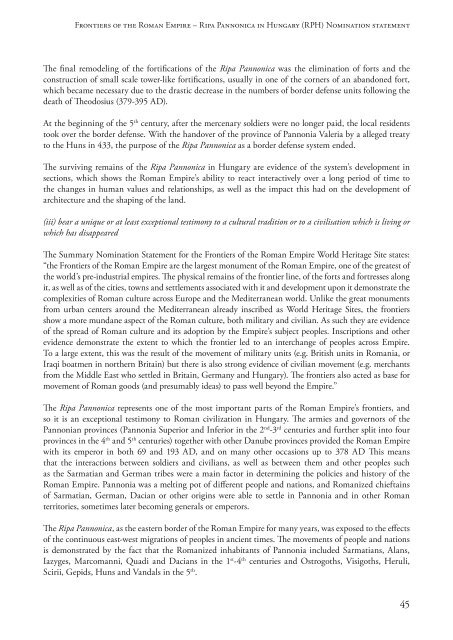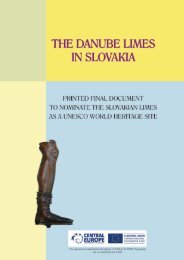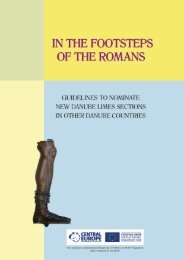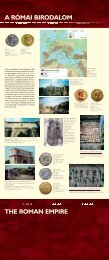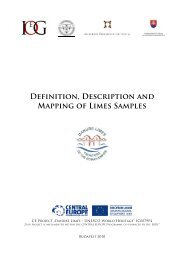the PDF version! - Danube Limes
the PDF version! - Danube Limes
the PDF version! - Danube Limes
You also want an ePaper? Increase the reach of your titles
YUMPU automatically turns print PDFs into web optimized ePapers that Google loves.
Frontiers of <strong>the</strong> Roman Empire – Ripa Pannonica in Hungary (RPH) Nomination statement<br />
The final remodeling of <strong>the</strong> fortifications of <strong>the</strong> Ripa Pannonica was <strong>the</strong> elimination of forts and <strong>the</strong><br />
construction of small scale tower-like fortifications, usually in one of <strong>the</strong> corners of an abandoned fort,<br />
which became necessary due to <strong>the</strong> drastic decrease in <strong>the</strong> numbers of border defense units following <strong>the</strong><br />
death of Theodosius (379-395 AD).<br />
At <strong>the</strong> beginning of <strong>the</strong> 5 th century, after <strong>the</strong> mercenary soldiers were no longer paid, <strong>the</strong> local residents<br />
took over <strong>the</strong> border defense. With <strong>the</strong> handover of <strong>the</strong> province of Pannonia Valeria by a alleged treaty<br />
to <strong>the</strong> Huns in 433, <strong>the</strong> purpose of <strong>the</strong> Ripa Pannonica as a border defense system ended.<br />
The surviving remains of <strong>the</strong> Ripa Pannonica in Hungary are evidence of <strong>the</strong> system’s development in<br />
sections, which shows <strong>the</strong> Roman Empire’s ability to react interactively over a long period of time to<br />
<strong>the</strong> changes in human values and relationships, as well as <strong>the</strong> impact this had on <strong>the</strong> development of<br />
architecture and <strong>the</strong> shaping of <strong>the</strong> land.<br />
(iii) bear a unique or at least exceptional testimony to a cultural tradition or to a civilisation which is living or<br />
which has disappeared<br />
The Summary Nomination Statement for <strong>the</strong> Frontiers of <strong>the</strong> Roman Empire World Heritage Site states:<br />
“<strong>the</strong> Frontiers of <strong>the</strong> Roman Empire are <strong>the</strong> largest monument of <strong>the</strong> Roman Empire, one of <strong>the</strong> greatest of<br />
<strong>the</strong> world’s pre-industrial empires. The physical remains of <strong>the</strong> frontier line, of <strong>the</strong> forts and fortresses along<br />
it, as well as of <strong>the</strong> cities, towns and settlements associated with it and development upon it demonstrate <strong>the</strong><br />
complexities of Roman culture across Europe and <strong>the</strong> Mediterranean world. Unlike <strong>the</strong> great monuments<br />
from urban centers around <strong>the</strong> Mediterranean already inscribed as World Heritage Sites, <strong>the</strong> frontiers<br />
show a more mundane aspect of <strong>the</strong> Roman culture, both military and civilian. As such <strong>the</strong>y are evidence<br />
of <strong>the</strong> spread of Roman culture and its adoption by <strong>the</strong> Empire’s subject peoples. Inscriptions and o<strong>the</strong>r<br />
evidence demonstrate <strong>the</strong> extent to which <strong>the</strong> frontier led to an interchange of peoples across Empire.<br />
To a large extent, this was <strong>the</strong> result of <strong>the</strong> movement of military units (e.g. British units in Romania, or<br />
Iraqi boatmen in nor<strong>the</strong>rn Britain) but <strong>the</strong>re is also strong evidence of civilian movement (e.g. merchants<br />
from <strong>the</strong> Middle East who settled in Britain, Germany and Hungary). The frontiers also acted as base for<br />
movement of Roman goods (and presumably ideas) to pass well beyond <strong>the</strong> Empire.”<br />
The Ripa Pannonica represents one of <strong>the</strong> most important parts of <strong>the</strong> Roman Empire’s frontiers, and<br />
so it is an exceptional testimony to Roman civilization in Hungary. The armies and governors of <strong>the</strong><br />
Pannonian provinces (Pannonia Superior and Inferior in <strong>the</strong> 2 nd -3 rd centuries and fur<strong>the</strong>r split into four<br />
provinces in <strong>the</strong> 4 th and 5 th centuries) toge<strong>the</strong>r with o<strong>the</strong>r <strong>Danube</strong> provinces provided <strong>the</strong> Roman Empire<br />
with its emperor in both 69 and 193 AD, and on many o<strong>the</strong>r occasions up to 378 AD This means<br />
that <strong>the</strong> interactions between soldiers and civilians, as well as between <strong>the</strong>m and o<strong>the</strong>r peoples such<br />
as <strong>the</strong> Sarmatian and German tribes were a main factor in determining <strong>the</strong> policies and history of <strong>the</strong><br />
Roman Empire. Pannonia was a melting pot of different people and nations, and Romanized chieftains<br />
of Sarmatian, German, Dacian or o<strong>the</strong>r origins were able to settle in Pannonia and in o<strong>the</strong>r Roman<br />
territories, sometimes later becoming generals or emperors.<br />
The Ripa Pannonica, as <strong>the</strong> eastern border of <strong>the</strong> Roman Empire for many years, was exposed to <strong>the</strong> effects<br />
of <strong>the</strong> continuous east-west migrations of peoples in ancient times. The movements of people and nations<br />
is demonstrated by <strong>the</strong> fact that <strong>the</strong> Romanized inhabitants of Pannonia included Sarmatians, Alans,<br />
Iazyges, Marcomanni, Quadi and Dacians in <strong>the</strong> 1 st -4 th centuries and Ostrogoths, Visigoths, Heruli,<br />
Scirii, Gepids, Huns and Vandals in <strong>the</strong> 5 th .<br />
45


